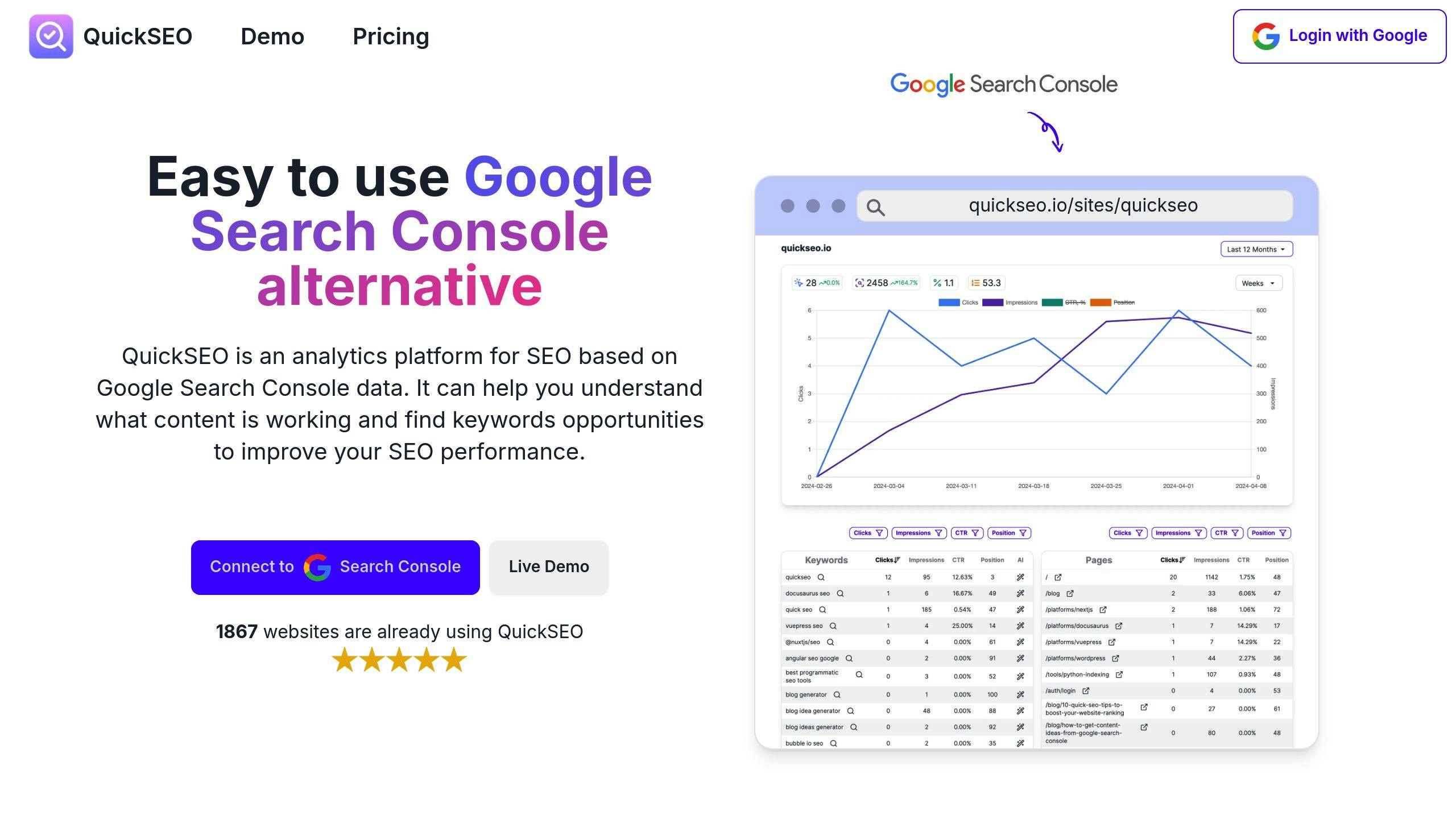
AI is transforming content strategies by saving time, improving accuracy, and boosting engagement. From creating SEO-friendly content to optimizing distribution and personalization, AI tools are making content marketing faster and more effective. Here's a quick summary of how AI can help:
| Tool | Primary Use | Key Feature |
|---|---|---|
| Jasper AI | Content creation | Smart templates for blogs & ads |
| QuickSEO | Keyword research | Real-time data and smart filtering |
| HubSpot | Audience targeting | Behavioral analysis and insights |
| SEMrush | Performance tracking | Content gap analysis |
| Buffer | Content distribution | Timing optimization |
AI tools are assistants, not replacements. Use them to streamline tasks, analyze data, and improve your strategy while keeping a human touch for creativity and authenticity.
AI tools for content creation use advanced technology to help marketers produce content quickly and efficiently. These platforms combine smart features with practical applications, making them a valuable resource for various content needs.
Here are some examples of popular AI tools and their primary uses:
| Tool | Purpose | Standout Feature |
|---|---|---|
| Jasper AI | Blog & Marketing Content | Smart Templates |
| Synthesia | Video Content | AI Avatar Creation |
| WriteSonic | SEO-Optimized Content | Multi-Language Support |
| Rytr | Social Media Posts | Engagement Analytics |
These tools are budget-friendly, with plans starting at just $22 per month. To get the most out of them, keep these tips in mind:
Integrating AI tools into your workflow can streamline tasks like content brainstorming and keyword research. Use them to create initial drafts, but ensure a human touch for quality and tone. Once published, AI analytics can provide valuable performance metrics to guide future improvements [3].
It’s important to see these tools as assistants, not replacements. While they help optimize for SEO and analyze metrics, the human element remains essential for creativity and authenticity. They can even simplify keyword research, helping your content rank better online.

QuickSEO takes keyword research to the next level with its AI-driven analytics platform. By blending advanced SEO tools with machine learning, it pinpoints keyword opportunities and delivers clear, actionable recommendations for content improvement. This tool works seamlessly alongside others, focusing on keyword performance and optimization.
One standout feature is its smart filtering system, which organizes keywords and pages based on performance metrics. This makes it easy for content creators to spot high-potential keywords and identify areas where content needs improvement. With these tools, QuickSEO becomes a powerful ally in sharpening your content strategy.
Here’s a breakdown of QuickSEO’s key features and how they can strengthen your approach:
| Feature | What It Does | How It Helps Your Strategy |
|---|---|---|
| Advanced SEO Analytics | Pulls real-time data from Google Search Console | Enables decisions based on up-to-date performance data |
| Smart Filtering | Groups pages by type automatically | Helps focus optimization on specific content areas |
| AI Content Generation | Offers diverse, SEO-friendly content ideas | Sparks new ideas for creating and refining content |
| Performance Tracking | Tracks keyword rankings and page metrics | Guides adjustments based on measurable outcomes |
The platform’s centralized dashboard simplifies managing multiple websites, making it a great option for individuals and agencies alike. Plus, its pricing is designed to fit a range of budgets.
QuickSEO doesn’t just help you find keywords - it also suggests content ideas, such as blog topics, Q&A sections, and optimized headings. This integration of keyword data with content creation ensures your material is both search-engine friendly and audience-focused. You can fine-tune existing content for better results while uncovering new growth opportunities.
Predictive analytics leverages AI to analyze user data, identifying patterns in behavior and preferences. By processing large datasets, these tools empower content strategists to develop more precise and impactful strategies.
For example, HubSpot's predictive analytics integrates seamlessly with CRM systems. It provides real-time insights into audience behavior and automated content recommendations. This helps content teams pinpoint high-value audience segments and craft tailored strategies to engage them effectively.
Here’s a look at how some popular predictive analytics tools influence content strategies:
| Tool | Primary Function | Impact on Content Strategy |
|---|---|---|
| HubSpot Analytics | Tracks customer behavior | Reduces content waste by 40% through better targeting |
| BrightEdge | Predicts content performance | Improves relevance by analyzing search trends |
| Concured | Analyzes topics and trends | Identifies emerging topics early |
Another standout example is StoryChief. Its AI combines predictive analytics with content distribution, dynamically adjusting publishing schedules and channel choices based on audience engagement patterns. This ensures content reaches the right people at the best possible times.
How to Get Started:
One fitness app used predictive analytics to boost app downloads by 20% and increase user engagement by 30% [3]. By aligning content with audience interests, they achieved meaningful results.
For content strategists, the key is selecting tools that match your business goals and pairing predictive analytics with AI-powered tracking. This approach helps refine strategies and maximize impact.
AI-powered analytics makes tracking content performance faster and more efficient by providing real-time insights that are easy to act on. These tools automate data collection, simplify analysis, and point out areas that need improvement.
Modern platforms integrate with tools like social media dashboards and CRM systems, offering instant feedback on how your content is performing. Here's a breakdown of how some top AI analytics tools can help:
| Analytics Tool | Key Feature | How It Helps |
|---|---|---|
| SEMrush | Content gap analysis | Spots missed opportunities for content creation |
| Clearscope | Content optimization | Boosts search rankings with data-backed recommendations |
| MarketMuse | Topic clustering | Makes content more relevant and authoritative |
| Parse.ly | Real-time engagement tracking | Helps fine-tune timing and distribution strategies |
These tools analyze metrics like click-through rates and time spent on a page to identify what works and what doesn’t. By recognizing successful patterns and offering suggestions, they turn raw data into actionable strategies.
To make the most of AI-powered analytics:
For content strategists aiming to get the best results, combining AI analytics with automated tracking tools is a smart move. Platforms like Parse.ly and Clearscope are changing the game by helping teams measure and improve their content with precision and ease [5].
Machine learning builds on predictive analytics by analyzing user behavior to deliver customized content, increasing engagement and conversions. It allows businesses to go beyond basic personalization, creating deeper connections with their audience.
Top companies use AI-driven models to offer experiences like tailored recommendations and dynamic landing pages. Here's how some platforms support content personalization:
| Platform | Key Feature | Business Impact |
|---|---|---|
| HubSpot | Behavioral analysis | Suggests content automatically based on user journey insights. |
| Concured | Content intelligence | Recommends topics aligned with audience preferences. |
| BrightEdge | Predictive insights | Optimizes content in real-time using user engagement patterns. |
| Surfer | Content performance tracking | Provides SEO-focused personalization suggestions. |
To make the most of machine learning for personalization:
Machine learning tools excel at identifying patterns in historical data, helping refine personalization strategies. However, the goal should always be to create meaningful, relevant experiences for your audience - not just to collect more data.
Once your personalized content is ready, AI can also help distribute it effectively, ensuring it reaches the right people at the right time.
AI-driven tools for content distribution and scheduling help analyze audience behavior to determine the best times and platforms for posting. These tools keep your content strategy aligned with how and when your audience engages.
Here are some platforms that automate and simplify content distribution:
| Platform | Key Features | Benefits |
|---|---|---|
| AI Content Genie | Automates social posts, hashtags, and scheduling | Reduces manual effort in content creation and posting |
| Planable | CRM integration, audience segmentation, automated scheduling | Makes content distribution more efficient |
| Buffer | Timing optimization powered by AI, engagement analytics | Increases engagement by posting at optimal times |
To get the most out of AI tools for content distribution, focus on these three areas:
Smart Scheduling Optimization
AI algorithms analyze past engagement data to determine when your audience is most active. This ensures your content is posted when it’s most likely to be seen.
Cross-Platform Content Adaptation
AI tools can tailor your content for different platforms automatically. For example, WriteSonic adjusts the tone and format of your content to fit each platform while keeping your branding consistent [4].
Performance Tracking and Adjustment
AI-powered analytics monitor how your audience interacts with your content. Tools like MarketMuse provide detailed insights into engagement trends, allowing you to refine your strategy and adjust schedules as needed [4].
AI-powered analytics tools are changing how content strategies are refined. By analyzing performance data, these tools uncover patterns that might go unnoticed by human analysts, offering actionable insights for improvement.
Here’s how some popular AI platforms assist in optimizing content strategies:
| Platform | Key Features | Benefits |
|---|---|---|
| Concured | Content audits, topic research, performance tracking | Highlights high-engagement topics and uncovers content gaps |
| HubSpot Content Strategy | Topic cluster analysis, competitor research | Recommends topics aligned with audience interests and competitor trends |
| Surfer | Keyword analysis, content performance metrics | Suggests improvements for existing content to boost performance |
Tools like HubSpot's Content Strategy Tool analyze competition and audience relevance to validate content ideas. This allows marketers to make quick adjustments that improve performance. AI also predicts which content elements are likely to perform well, helping teams focus on creating targeted, engaging material. For example, Concured uses historical data to recommend topics and formats tailored to specific audiences [5].
Platforms like Surfer and NeuralText use keyword and engagement data to suggest ways to improve underperforming content [4]. These recommendations make it easier to ensure every piece of content achieves its potential, whether through better keyword usage or more engaging formats.
The best results come from blending AI insights with human creativity. AI can uncover opportunities and patterns in data, but it’s up to marketers to use these insights for strategic and creative decisions. This combination ensures content is both optimized for performance and engaging for your audience.
AI has reshaped how marketers develop and execute content strategies, offering tools that improve both productivity and results. These tools simplify content creation and strategy adjustments while ensuring consistent messaging across various platforms [2][4].
Beyond mere automation, AI combines efficiency with data-driven insights. It helps marketers understand audience behavior and track performance, empowering them to make smarter decisions that influence outcomes. Tools designed to identify content gaps and refine strategies also play a role in forecasting and boosting content success [4].
Success hinges on balancing AI's capabilities with human creativity. While AI handles data analysis and repetitive tasks with ease, human judgment is essential for strategic planning and preserving a brand's unique voice [3]. By enhancing content creation, analytics, and distribution, AI tools contribute to better efficiency and stronger audience engagement.
As technology advances, AI's influence on content strategy will only grow. Marketers who adopt AI-driven tools will position themselves ahead of the competition. The future lies in combining AI's analytical strengths with human ingenuity to create content that resonates and connects authentically [1][5].